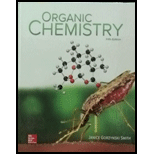
Concept explainers
(a)
Interpretation: All constitutional isomers formed by the monochlorination of given alkane is to be drawn.
Concept introduction: Halogens react with
(b)
Interpretation: All constitutional isomers formed by monochlorination of given alkane is to be drawn.
Concept introduction: Halogens react with alkanes in presence of heat or light to form alkyl halides. This is known as halogenation reaction. This is a free radical substitution reaction. In this the halogen substitutes the hydrogen atom from
(c)
Interpretation: All constitutional isomers formed by monochlorination of given alkane is to be drawn.
Concept introduction: Halogens react with alkanes in presence of heat or light to form alkyl halides. This is known as halogenation reaction. This is a free radical substitution reaction. In this the halogen substitutes the hydrogen atom from
Trending nowThis is a popular solution!

Chapter 15 Solutions
ORGANIC CHEMISTRY-W/ACCESS >CUSTOM<
- Give an IUPAC name for the following as hydrocarbons with the benzene ring as a substituent: a. b.arrow_forwardDraw all constitutional isomers formed by monochlorination of each alkane with Cl2 and hv.arrow_forwardGive 1 example each for Alkynes. Structure should contain 5 carbons with branching and substituents and provide the IUPAC name.arrow_forward
- kindi give the IUPAC namearrow_forwarda. What is the chemical structure of biphenyl, circle functional groupsdifferent than alkane, alkene, alkyne? b. Is it polar or nonpolar? _______________________ c. What is its water solubility in g/L? __________________________arrow_forwardDraw the products of combustion of each alkane.arrow_forward
- (a) which a disubstituted cis- alkene? (b) which is the geometric isomer of D? (c) which is a tri-substituted Z- alkene? (d) which is the most stable alkene? (e) which has the highest boiling point? (f) which has the highest MP?arrow_forwardSeveral factors can affect alkene stability. Explain why alkene A is more stable than alkene B even though both contain disubstituted carbon–carbon double bonds.arrow_forwardDraw the structure corresponding to following IUPAC name. sec-butylcyclopentanearrow_forward
 Introductory Chemistry: An Active Learning Approa...ChemistryISBN:9781305079250Author:Mark S. Cracolice, Ed PetersPublisher:Cengage Learning
Introductory Chemistry: An Active Learning Approa...ChemistryISBN:9781305079250Author:Mark S. Cracolice, Ed PetersPublisher:Cengage Learning Chemistry for Today: General, Organic, and Bioche...ChemistryISBN:9781305960060Author:Spencer L. Seager, Michael R. Slabaugh, Maren S. HansenPublisher:Cengage Learning
Chemistry for Today: General, Organic, and Bioche...ChemistryISBN:9781305960060Author:Spencer L. Seager, Michael R. Slabaugh, Maren S. HansenPublisher:Cengage Learning


